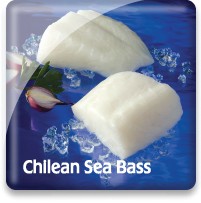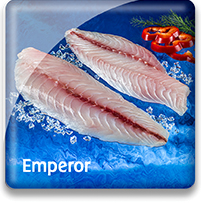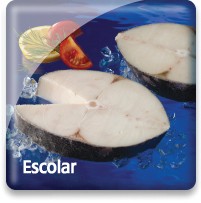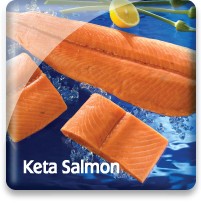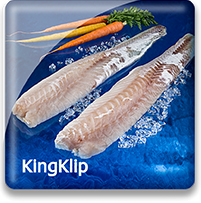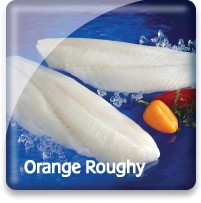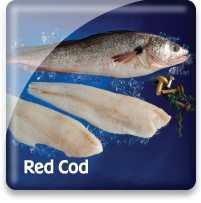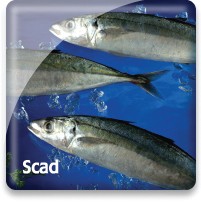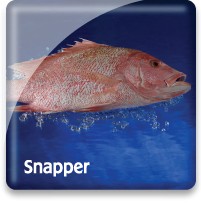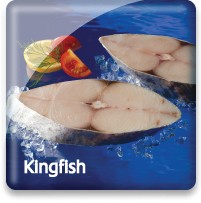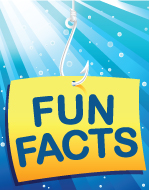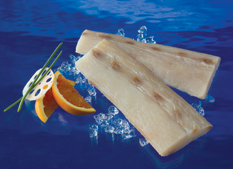
Mahi Mahi

Market Name: Eating QualitiesMahi-Mahi has a sweet, mild-to-moderate flavor. It is lean with fairly firm large flakes.
Mahi mahi means “very strong” in Hawaiian.
|
Description & CharacteristicsThe raw flesh of Mahi-Mahi is firm and is light whitish pink to light cream in color. This lean meat cooks quickly to form moist flakes that have a mild-to-moderate sweet flavor. The bloodline is often removed before cooking because of its dark appearance and the fact it can have a stronger flavor. Mahi-Mahi is suitable for broiling, grilling, steaming, baking, or frying. Mahi-Mahi is commonly known as dolphin fish, however most marketers avoid the label. The Spanish name is Dorado. The fish is a brilliant blue, green and silver color with yellow spotting. The belly is usually white or yellow. The color quickly fades when the fish is landed. It has a crested, round head, which resembles a dolphin. Males tend to have more color than females. They can grow to be over six feet. Most fish are typically between 8 and 25 pounds. Mahi-Mahi has a life span of approximately five years. Mahi-Mahi is found worldwide in the tropics and sub-tropic waters of the Atlantic, Pacific and Indian Oceans. It is the state fish of Hawaii and highly regarded among sport fishermen for its fighting ability. Although landings take place year round, they usually increase seasonally from March to May and from September to November, as the fish follow warm currents. Sea Port sources primarily from Taiwan where the peak fishing takes place March through August. Commercial fishing of Mahi-Mahi is conducted by trawl, pole and line, and industrial longline. Mahi-Mahi catch size varies greatly from a couple of pounds to over 50 pounds, so the size and thickness of fillets is varied. Mahi-mahi that is over 10 or 15 pounds is the preferred market size. The average yield of the fish is about 40-45 percent of the total body weight. Mahi-Mahi is sold fresh as whole, typically head and gutted (H&G). Sometimes, however, it is sold with the head on. Mahi-Mahi comes domestically from the Gulf of Mexico, and imports arrive from Central and South America and Asia. Domestic Mahi-Mahi tends to be smaller fish and yields less meat. Therefore, domestic fish normally trades for less than imported larger fish. Mahi-Mahi is also sold as fillets, loin, fletches, and portions, and these are mostly frozen with product coming generally from Asia and Central and South America. Asian product comes predominantly from Taiwan and Indonesia whose fishing season runs approximately from March to August depending on the warm currents; in the last couple of years fishing has taken place in or around May. Central and South American Mahi-Mahi comes mainly from Ecuador, Peru, Panama, and Costa Rica, with its fishing season running approximately from September to November. In recent years, the fishing season has been extended to December and sometimes January. Mahi-Mahi that has been improperly handled can produce histamine that can cause scrombroid poisoning. Proper landing, temperature control, and hygienic handling practices can prevent bacteria from creating the enzyme histidine carboxylase that precipitates the formation of histamine in Mahi-Mahi. Sea Port's Taiwan Mahi-Mahi, consisting of 80% industrial longline and 20% small artisanal dayboat trawl caught are properly handled to avoid the formation of histamine. Industrial longline Mahi-Mahi are quickly gutted onboard and frozen at -35 C°. Artisanal dayboat production is iced whole onboard and then delivered to the processing plant where it is properly processed and frozen.
Other Resources |
Handling Instructions for Mahi-Mahi
Frozen Mahi-Mahi fillets, portions and loins should be stored at or below 0°F (-18°C) and then thawed properly when ready to cook. Our mahi mahi has an 18 month frozen shelf life. Links to proper seafood handling instructions: NOAA - Fish Watch: Handling Seafood and A Consumer Guide to Safe Seafood Handling.
Thawing Mahi-Mahi
Thawing is accomplished by removing the fillets, portions, and loins from their original packaging and placing them in a sealed plastic container or bag and placing in the refrigerator (33 to 39°F) for 12-24 hours or until completely thawed. This is our recommended thawing method for Mahi-Mahi fillets, portions, and loins. Mahi-Mahi that is not consumed promptly after thawing needs to be refrigerated between 33 and 39°F and totally consumed in 2-3 days.
Important Instructions for Mahi-Mahi
Consuming Mahi-Mahi immediately after proper thawing yields the best quality. Mahi-Mahi is naturally high in the essential amino acid histidine and must be kept under proper refrigeration (33-39°F) once thawed to prevent the formation of histamine that can cause an allergic type reaction called scombroid poisoning. Histamine may be formed from histidine at unsafe holding temperatures over 40°F if certain bacteria are present. To prevent this, always store thawed Mahi-Mahi at between 33-39°F.
The Federal Food, Drug and Cosmetic Act now requires that all foods that are not raw agricultural commodities and that contain a major food allergen be labeled to clearly identify the name of the food source form which the allergen is derived. (21 CFR U.S.C. 343(w)(1)). The act defines eight foods, and any ingredients derived from these foods as major food allergens: Fish, Crustacean Shellfish, Milk, Eggs, Tree Nuts, Peanuts, Wheat & Soybeans. The name of the food source that must be listed on the label for fish or crustacean shellfish must be the specific type of fish or crustacean shellfish. The market names of species of fish and crustacean shellfish should be used to identify the food source of these two major food allergens. If you intend to re-pack these seafood products, be sure the allergen is declared in either one of two ways:
1) Within the list of ingredients
or
2) In a separate “Contains” statement immediately after or adjacent to the list of ingredients.
Consult the Fish and Fishery Products Hazards and Controls Guidance, Fourth Edition, Chapter 19 for more detailed information on the labeling of food allergens.
Cooking Tips
Mahi-Mahi can be prepared using a wide variety of cooking techniques. Links to mahi mahi cooking tips and recipes.
Taiwan
The island of Tawian, shaped like a tobacco leaf, nation, is located off the coast of China where it is officially part of the Republic of China. Some 23 million people live in an area that is just 245 miles long and 89.5 miles wide, making Taiwan the second-most densely populated country in the world.
While it offers few opportunities for recreational fishing, Taiwan’s commercial fishing industry is well-established, with a fleet of vessels that fish around the world for tuna, sharks, herring, reef fish, horse mackerel, sardines, squid and octopus. Aquaculture is also an important new industry in Tawian, with freshwater farms growing shrimp farms, and tilapia, and marine farms growing shellfish such as clams and oysters.
Go Blue! Seafood Sustainability Spectrum*Click here for an explanation of our Sustainability Spectrum 
Sustainability AssessmentMahi Mahi (also commonly spelled as mahi-mahi or called the common dolphinfish) is a highly migratory, open ocean species common in tropical and sub-tropical oceans worldwide. They are highly fecund and spawn year-round. Because they grow quickly, have a short life span, and spawn frequently, they are relatively resistant to fishing pressure.
Sea Port’s supply of Mahi Mahi is caught as bycatch by Taiwan’s distant water tuna fleets, and also by smaller artisanal-style, longline vessels fishing closer to shore. Sea Port sources approximately 80% of their Mahi Mahi from the artisanal-style longline fisheries. Longline fisheries generally have minimal negative impacts on the seafloor because they do not come in contact with the bottom; however, there are substantial problems with bycatch of protected, endangered, and threatened species (PET) with this gear type. There are no known stock assessments for Mahi Mahi, and they are not currently managed at the national or international level in the Indian and Pacific Oceans, where Sea Port sources. .jpg)
Environmental Impact: Moderate to HighThough Mahi Mahi are resistant to overfishing, and longlines have low habitat impacts because they do not make contact with the sea floor, bycatch of PET species is likely to be high in both the offshore and near shore components of this fishery. There is no observer coverage or available data on bycatch species. There are no stock assessments for Mahi Mahi.
Sustainability Improvements NeededStock assessments, management plans and quotas are needed for the Mahi Mahi fishery to avoid the possibility of overfishing.
Actions that Sea Port is UndertakingSea Port believes that the high fecundity and growth rate of Mahi Mahi is currently guarding it from becoming overfished and the artisanal nature of the bulk of its suppliers further guards against over exploitation. Sea Port is requiring that their suppliers provide fishing vessel identification (when available), catch methodology, and catch area information. In doing so, Sea Port may be encouraging the Mahi Mahi fishery to collect additional harvest data which could set the stage for future fishery management improvements. Sea Port believes that, in aggregate, choosing from a diverse variety of seafood is better for sustaining the world’s seafood resources and Mahi Mani should be a part of this variety.
We created the sustainability assessments for each of our seafood items in order to reveal the existing and potential environmental impacts and risks that are associated with producing them for human consumption. This allowed us to establish the starting position for each of our seafood items along our progressive Go Blue! Seafood Sustainability Spectrum®. These assessments are only a single snapshot in time and because of this, we will continue to assess and update the critical sustainability needs associated with our supply sources and issue updates to the Go Blue! Seafood Sustainability Spectrum® as needed. There is a growing global awareness for the need to assure the sustainability of farmed and wild caught seafood and because of this; all around the world positive changes are rapidly occurring at all levels of the seafood supply chain. We will continue to spread this growing awareness and work with our many industry partners to improve the sustainability of all seafood, which we believe is the ideal protein of choice to feed an ever growing world population. Our Go Blue! Seafood Sustainability Spectrum® serves as our compass and yardstick as we strive to move all our products forward to becoming more sustainable. Please join us in this committed quest and Catch Our Wave® to sustainability by choosing a diverse variety of responsibly produced seafood as part of your diet.
|


